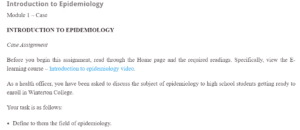Introduction to Epidemiology
Defining Epidemiology
Epidemiology is a discipline that studies the determinants and distribution of health-linked conditions among particular individuals/populations/groups and the utilization of that knowledge to regulate health issues (CDC, n.d.). Thus, the field of epidemiology principally aims to help diagnose the environmental, host, and agent factors that impact the well-being and health of a specific population, as well as to identify the relative significance of the various disease causes, injury, disability, and death. Epidemiologists, therefore, serve the important function of determining areas with the highest risk of suffering from a particular cause of disease or ill health. They also analyze the efficiency and success of various health services and programs designed to enhance population well-being and health.
Historical Evolution of the Field of Epidemiology and Epidemiologic Concepts
Although epidemiology seemed to flourish after the Second World War, epidemiological ideologies have existed with humankind since Hippocrates. The following list briefly shows how the field has evolved throughout history:
- 400 BC (Circa) – Hippocrates opined in his editorial titled “On Airs, Waters, and Planes” that host and environmental factors might be the cause or reason behind the occurrence of diseases (CDC, 2012).
- 1662 – UK national John Graunt was credited for being the first scientist to issue and publish a mortality data analytic report. He became the first epidemiology scientist to quantify disease incidence, death, and birth rate trends, describing the various differences in seasons, rural/urban settings, females and males, and high infant mortalities.
Introduction to Epidemiology
- 1800 – Farr William, who is known to many as the “father of vital statistics,” continued on John’s discovery by categorically gathering and analyzing mortality figures in Great Britain. Farr designed and pioneered most of the practices and concepts used in today’s classification and statistical analysis of diseases (Thacker, 2002).
- 1854 – John Snow successfully discovers the cause of cholera. He was the first scientist to use modern descriptive and analytic epidemiology effectively, including hypothesis development and testing.
- 19th and 20th centuries – Epidemiologic tools were increasingly employed in analyzing disease incidence/occurrence in the mid and late 19th century but were limited to acute infections. In the 1930s and 40s, epidemiological analytics techniques were extended to noninfectious conditions. The Second World War saw a boom in the growth of research methods in epidemiology. Healthcare experts employed epidemiologic techniques to eradicate smallpox globally between the 1960s and 70s (CDC, 2012).
Explanations of Epidemic and Outbreak
An epidemic simply refers to an unexpected surge in the quantity/amount/number of disease incidences/cases in an area or population, usually beyond what is expected in that particular region/population. An outbreak also bears a similar definition and meaning as the term epidemic but is commonly applied when referring to a sudden rise in infection cases in a more limited or smaller geographic location. The scale of an outbreak is smaller than an epidemic (Grennan, 2019).
The Introduction to Epidemiology Video
On July 21, 1976, a three-day conference was launched by the “American Legion” association at a lodge in Philadelphia known as the Bellevue-Strafford Hotel. The event attracted approximately 2000 attendees. Three days after the conference came to a close (July 27), 61-year-old Ray Brennan (a Legionnaire attendee) died from a heart attack at his home. Aveni Frank (another attendee) and three other Legionnaire attendees passed on mysteriously on July 30 of a heart attack. One day later, another six died, with all complaining of fever, lung congestion, chest pains, and tiredness. In total, approximately 149 Legionnaires and an additional 33 individuals linked with the restaurant felt sick, and 29 of these cases died (Fraser et al., 1977).
The first and most critical step the Health Department or officials in Pennsylvanian should have taken was to acknowledge and identify the presence of a disease outbreak. The Department should have used data from health centers where the patients were hospitalized to identify and acknowledge the occurrence of an outbreak. It was clear that the first cluster of 14 patients reported similar symptoms and died from almost similar causes. The Department could also have used data from numerous sources to confirm that the cases were above the normal rate of the earlier suspected flu virus (CDC, n.d.).
References
CDC. (2012). Lesson 1: Introduction to epidemiology. Retrieved from https://www.cdc.gov/csels/dsepd/ss1978/lesson1/section2.html
CDC. (n.d.). Public Health 101 series: A foundational learning tool about public health [Video]. CDC. https://www.cdc.gov/publichealth101/e-learning/epidemiology/
Grennan, D. (2019). What is a pandemic? JAMA Patient Page, 321(9), 910. doi:10.1001/jama.2019.0700
Thacker, S. B. (2002). Historical development. In: Teutsch S. M., Churchill R. E., editors. Principles and practice of public health surveillance, 2nd ed. New York: Oxford University Press.
Fraser, D. W., et al. (1977). Legionnaires’ disease — description of an epidemic of pneumonia. New England Journal of Medicine, 297(22), 1189–97. doi:10.1056/NEJM197712012972201
ORDER A PLAGIARISM-FREE PAPER HERE
We’ll write everything from scratch
Question
Introduction to Epidemiology
Module 1 – Case
INTRODUCTION TO EPIDEMIOLOGY
Case Assignment
Before you begin this assignment, read through the Home page and the required readings. Specifically, view the E-learning course – Introduction to epidemiology video.
As a health officer, you have been asked to discuss the subject of epidemiology to high school students getting ready to enroll in Winterton College.
Your task is as follows:
- Define to them the field of epidemiology.
- Briefly list a historical evolution of epidemiology.
- Explain the terms outbreak and epidemic.
- The Introduction to epidemiology video discussed the Legionnaire’s disease outbreak in 1976. Briefly describe the case in terms of time, place, and person; and, what should have been the first step the Pennsylvania Department of Health should have followed?
- Length: 2–3 pages, excluding title page and references.
Assignment Expectations
Assessment and Grading: Your paper will be assessed based on the performance assessment rubric. You can view it under Assessments at the top of the page. Review it before you begin working on the assignment. Your work should also follow these Assignment Expectations.



